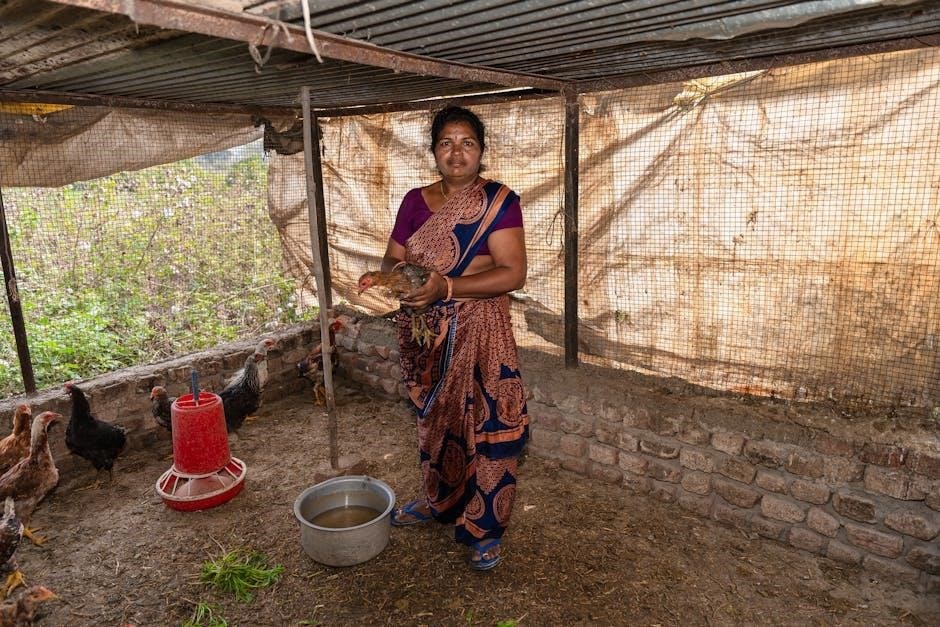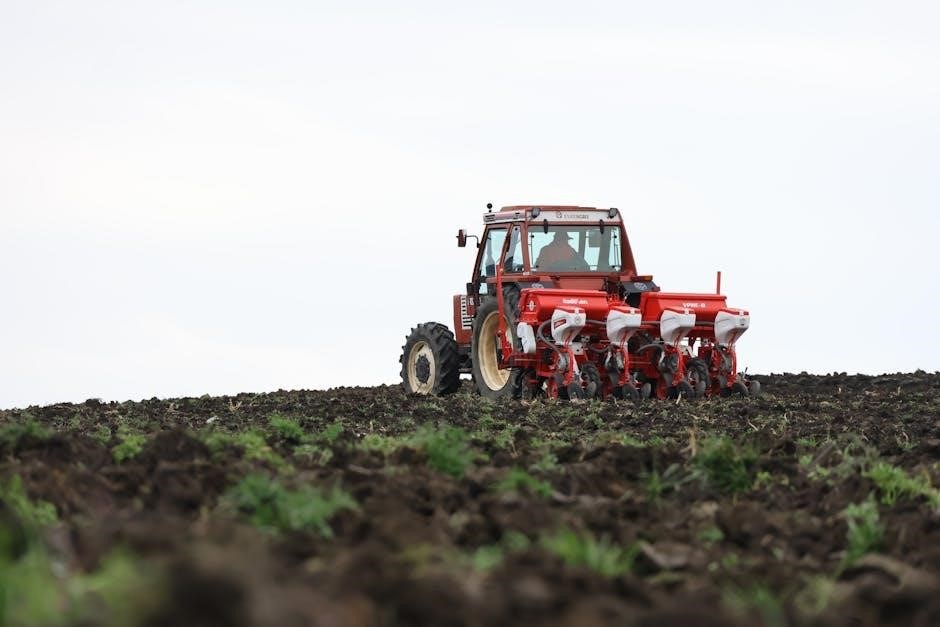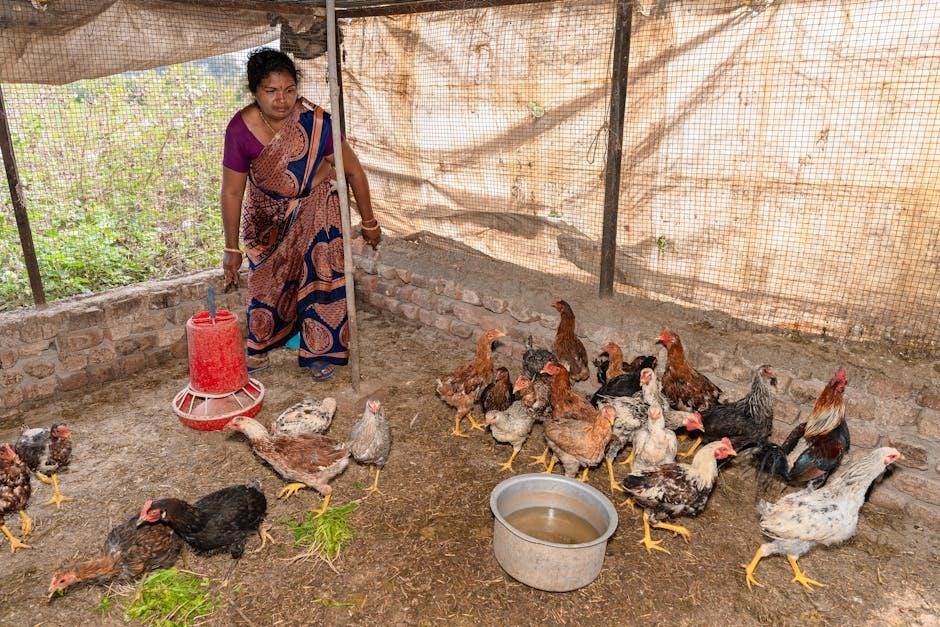Chicken Tractor Plans PDF: A Comprehensive Guide
Embark on your journey to sustainable poultry keeping with our comprehensive guide to chicken tractor plans in PDF format. Discover the benefits of mobile coops and how this guide helps you build one!
Chicken tractors, also known as mobile chicken coops, represent a sustainable and efficient approach to raising poultry. This method allows chickens to graze on fresh pasture, contributing to their health and well-being while simultaneously improving soil quality. By regularly moving the tractor, you provide your chickens with access to new foraging areas, reducing the need for supplemental feed and minimizing the buildup of waste in one location. This guide explores the concept of chicken tractors and how PDF plans can simplify the construction process. Whether you’re a seasoned homesteader or a beginner, understanding the basics of chicken tractors is essential for successful pastured poultry farming and building a sustainable system.

What is a Chicken Tractor?
A chicken tractor is a mobile coop designed to be moved regularly, providing chickens with fresh grazing areas. These structures support sustainable and healthy poultry practices.
Definition and Purpose
A chicken tractor, at its core, is a portable chicken coop. The main purpose of a chicken tractor is to provide a safe and easily movable space for chickens, allowing them access to fresh pasture. This design enables chickens to forage for food naturally, reducing feed costs and enriching their diet. By regularly moving the tractor, you distribute chicken manure evenly, fertilizing the soil and preventing the buildup of waste. This method promotes healthier chickens, healthier land, and a more sustainable approach to raising poultry. It combines the benefits of free-range with protection from predators.
Benefits of Using a Chicken Tractor
Using a chicken tractor provides numerous advantages for both the chickens and the owner. Firstly, it allows chickens to access fresh grass and insects daily, improving their health and the quality of their eggs or meat. Secondly, the mobility of the tractor distributes chicken manure evenly, naturally fertilizing the lawn and garden. This reduces the need for chemical fertilizers and improves soil health. Thirdly, it offers protection from predators like foxes and stray dogs, keeping the chickens safe. Lastly, it is a cost-effective solution, reducing feed costs as chickens forage for themselves.

Finding Chicken Tractor Plans
Discovering the perfect chicken tractor plans can be easy. A variety of resources offer designs suitable for all skill levels and flock sizes, both online and offline.
Free Chicken Tractor Plans Online
The internet offers a wealth of resources for finding free chicken tractor plans. Websites dedicated to homesteading, sustainable agriculture, and DIY projects often host a variety of plans suitable for different flock sizes and skill levels. Many plans are inspired by Joel Salatin’s pastured poultry coop designs, known for their efficiency and ease of construction.
These free plans typically come in PDF format, offering detailed instructions, material lists, and diagrams. Online forums and communities provide opportunities to ask questions and share experiences with other builders. Remember to carefully review the plans and adjust them to fit your specific needs and climate.

Where to Find PDF Plans
Locating chicken tractor plans in PDF format is easier than ever, thanks to the vast resources available online. Start by exploring websites dedicated to homesteading, DIY projects, and sustainable agriculture. Many of these sites offer free or low-cost PDF plans that you can download and print. Online marketplaces like Etsy also feature unique and customizable chicken tractor designs from independent creators.
Additionally, consider checking out forums and online communities related to backyard chickens and poultry keeping. Members often share their own plans or recommend valuable resources. Remember to research the plan’s creator and read reviews before downloading to ensure its quality and suitability for your needs.

Considerations When Choosing Plans
Selecting the right chicken tractor plan requires careful consideration of several factors. These include the size and capacity needed, mobility, design, materials for construction, and adapting them for climate.
Size and Capacity
When selecting chicken tractor plans, size and capacity are paramount. Determine the number of chickens you plan to house, as overcrowding can lead to stress and disease. A general rule is to provide at least 4 square feet per bird inside the tractor.
Consider the external dimensions, ensuring the tractor fits comfortably in your available space and is easily maneuverable. Larger flocks necessitate bigger tractors, impacting mobility. Evaluate your chickens’ breed as larger breeds need more space.
Plan for future expansion, too. A slightly larger tractor than initially needed offers flexibility. Consider your egg consumption or meat production goals, tailoring capacity accordingly for a sustainable design.
Mobility and Design
Mobility is a cornerstone of chicken tractor design. Evaluate how easily you can move the structure across your terrain. Consider wheel size and placement; larger wheels navigate uneven ground more effectively. A-frame designs offer simplicity and maneuverability, while others may prioritize space.
The design should incorporate handles or a towing system for effortless relocation. Consider the weight of the tractor, especially when fully occupied; Ensure the design allows chickens access to fresh pasture daily, a primary benefit of using a chicken tractor.
Adequate ventilation is crucial to prevent overheating and maintain air quality. The design should also protect against predators, with secure latches and durable materials. Consider the aesthetic, ensuring the tractor complements your backyard.
Materials and Construction
Carefully consider your material choices for long-lasting durability. Pressure-treated lumber resists rot and insect damage, ideal for the frame. Hardware cloth with small mesh is essential for predator protection, lining the base and sides. Roofing materials such as corrugated metal or heavy-duty plastic provide shelter from the elements.
Prioritize sturdy construction techniques, using screws and bolts instead of nails for added strength. Ensure all joints are secure and properly braced. Consider using half-lap joints for added stability. The construction should be simple enough for DIY assembly, but robust enough to withstand daily use and movement.
Pay attention to ventilation, incorporating screened openings for airflow; Choose materials that are easy to clean and maintain. Consider the overall weight of the materials, balancing durability with ease of mobility.
DIY Chicken Tractor Construction
Embark on building your own chicken tractor! This section provides guidance on essential tools, materials, and step-by-step instructions to create a mobile coop for your chickens.
Essential Tools and Materials
Before embarking on your chicken tractor construction, gather the necessary tools and materials to ensure a smooth and efficient building process. Essential tools include a circular saw for cutting lumber, a drill for assembling components, and measuring tools for accuracy. A hammer, chisel, and other hand tools will also prove useful.
Material-wise, lumber forms the primary structure, while hardware cloth or chicken wire provides secure enclosure. Roofing materials, such as metal sheets, offer weather protection. Consider using durable, weather-resistant materials. Wheels or skids will enable easy mobility. Screws, nails, and other fasteners are crucial for assembly. A comprehensive list ensures you’re well-prepared.
Step-by-Step Building Instructions
Constructing your chicken tractor involves a series of steps, beginning with framing the base. Cut lumber according to plan dimensions and assemble the rectangular base frame, ensuring square corners. Next, build the side and end walls, attaching them securely to the base. Add a roof structure, incorporating a slight slope for water runoff; the roof should overhang to provide shade.
Enclose the sides and roof with hardware cloth or chicken wire, stapling it tightly to the frame. Construct a door or access panel for easy chicken entry and cleaning. Attach wheels or skids to the base for mobility. Finally, inspect all connections for strength and stability, making any necessary reinforcements.
Adapting Plans for Specific Needs
Tailor your chicken tractor! Consider modifications for climate, breed, and space. Optimize ventilation for hot climates. Adjust dimensions for specific breeds. Customize features for unique requirements.
Modifying Plans for Hot Climates
When adapting chicken tractor plans for hot climates, focus on maximizing ventilation and minimizing direct sunlight. Incorporate features like elevated floors to promote airflow and shade cloth coverings to reduce heat exposure. Consider using reflective roofing materials to deflect sunlight and keep the interior cooler. Increase the size of ventilation openings and strategically position them to capture breezes. Provide ample shade within the tractor using natural materials like branches or vegetation. Always ensure a constant supply of fresh, cool water. Regularly monitor the temperature inside the tractor and adjust ventilation as needed to prevent overheating.
Adjusting for Different Chicken Breeds
Adapting chicken tractor plans for different breeds involves considering their size, activity level, and specific needs. Larger breeds require more space, so increase the overall dimensions of the tractor accordingly. Active breeds need more room to roam, so ensure ample foraging area within the tractor’s footprint. Breeds susceptible to cold may require insulated nesting boxes or windbreaks. For breeds prone to flying, consider a taller enclosure or netting to prevent escapes. Heavy breeds may benefit from a sturdier frame and reinforced flooring. Always research the specific needs of your chosen breed and adjust the plans accordingly.
Maintaining Your Chicken Tractor
Regular maintenance is crucial for the longevity of your chicken tractor. This includes cleaning, repairs, and protection from weather and predators, ensuring a safe and healthy environment for your flock.
Regular Cleaning and Upkeep
Maintaining a clean chicken tractor is paramount for the health and well-being of your flock. Regular cleaning prevents the buildup of harmful bacteria and parasites, reducing the risk of disease. Scrape out and replace soiled bedding frequently, ideally every few days, to minimize ammonia buildup.
Periodically wash down the interior surfaces of the tractor with a mild disinfectant to eliminate pathogens. Inspect the structure for any signs of wear and tear, such as loose screws or damaged wood, and make necessary repairs promptly. Ensure that ventilation is adequate to prevent moisture accumulation, which can foster mold growth.
Proper cleaning and upkeep not only benefit your chickens but also extend the lifespan of your chicken tractor.
Protecting Against Predators
Safeguarding your chickens from predators is crucial for their survival and your peace of mind. A well-designed chicken tractor should incorporate robust security measures to deter potential threats. Use heavy-gauge wire mesh with small openings to enclose the sides and bottom of the tractor, preventing animals from digging underneath or reaching through.
Reinforce any weak points in the structure, such as corners or seams, with additional hardware. Consider adding a skirt of wire mesh around the perimeter of the tractor to further discourage digging predators. Regularly inspect the tractor for any signs of breaches or damage and repair them immediately.
Secure latches and locks on doors and access points are essential to prevent predators from gaining entry.

Leave a Reply
You must be logged in to post a comment.